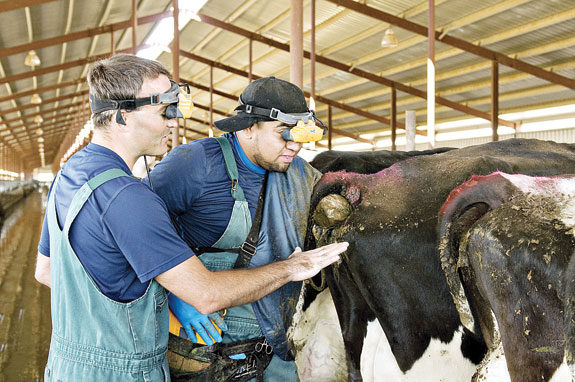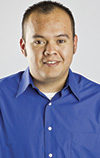According to a 2007 survey conducted by the USDA’s National Animal Health Monitoring System, someone other than a veterinarian performed approximately one-third of pregnancy exams on dairies in the West, and approximately one-quarter of exams on dairies with more than 500 cows nationally. With these survey results in mind, veterinarian Kevin McSweeney of Loveland, Colorado, began laying out the groundwork for a program to help train individuals in becoming ultrasound technicians.
“It makes sense that a dairy with more than 500 or 1,000 cows would want to have somebody with ultrasound equipment in their hands every day,” McSweeney says.
In late May, McSweeney’s work became a reality with the launch of International Bovine Training Solutions.
“I want to be able to teach people not only the nuts and bolts of using ultrasound, but how to make it more effective when utilized on the dairies,” he says. “It’s a shame not to put it to its full potential use on these dairies.”
Working with ultrasound
McSweeney is no stranger to working in dairy reproduction. He grew up around dairy cattle and was previously employed as a herd manager on dairies in Virginia and Colorado.
He attended Colorado State University’s veterinary school, where he worked for reproductive physiologist George Seidel, well known for his work in embryo transfer and developing the sexed semen technology used throughout the industry today.
“We were breeding cows in the West and, instead of waiting for them to calve, we would use ultrasound and fetal sex to make sure we were sorting the semen correctly,” McSweeney says. “That’s where I learned ultrasound originally and where I really got my feel for reproduction and insight for what it takes to get cows bred.”
After veterinary school, McSweeney pursued a master’s degree that focused on using ultrasound in bovine reproduction.
During the coursework, he says he stumbled upon tricks with ultrasound to determine if timed-A.I. cows were synchronizing or not. Since then, he has incorporated ultrasound into reproductive management protocols in TAI breeding programs for his clients.
McSweeney explains that, although he has trained people in the past, this was only a side project, with his focus remaining on running his veterinary practice. That focus has now shifted to his new training enterprise, he says.
“I’ve positioned my practice so that I’ve freed myself up enough to be able to devote the one-on-one time necessary for training,” McSweeney says.
Tailoring to individual needs
The training program enrolls anyone who would like to be trained, regardless of previous experience in using ultrasound technology. McSweeney has geared the program to make it versatile in meeting the needs of individual trainees.
“I can tailor the training to whatever the trainees are wanting,” McSweeney says. “Somebody might want to just work on fetal sexing or focus on ovarian dynamics – some people might just want an introduction to ultrasound.”
Getting veterinarians on-board with his training structure is another goal of McSweeney’s. “It’s a very sensitive issue for veterinarians because, for a lot of them, this is their bread and butter,” he says.
With the reduced numbers of veterinarians in the West, where there are more and more cows and less and less veterinary hours available, McSweeney explains that it doesn’t make sense for veterinarians to be doing all of the pregnancy diagnosis.
“I would like to see more veterinarians try to follow my model and incorporate more technicians into their practices for pregnancy diagnosis and incorporating some advanced protocols around synchronization to better serve their clients,” McSweeney says.
Since his practice was established, McSweeney explains that he has trained between 100 and 150 people. Additionally, he speaks Spanish and has trained Hispanic herdsmen and employees in the past, which is also an option available to participants.
“I want the program to provide a labor sink for me to be able to have employees – college graduates and immigrant labor – for an amount of time, get them to a certain competency level and be able to place them with veterinary practices or large dairies,” he says.
Format of the program
The basic setup of the program will consist of hands-on sessions during the morning followed by afternoon classroom instruction sessions.
“Ideally, I envision people coming for multiple days because ultrasound work is like learning a video game – you can’t learn that hand-eye coordination and be perfect at it the first day,” he says.
Although there is not a set central location for the program, McSweeney hopes to have a designated training facility within the next year.
He explains that the hands-on ultrasound training will take place on his clients’ herds, many of which are in the 3,000-cow range. Working with these larger herds will expose trainees to a large number of animals, helping them to better grasp ultrasound work in a large-scale setting.
“The number of cows is the true power in learning ultrasound,” he says. “That’s how I have trained my technicians and other people in the past.”
The afternoon sessions will consist of lectures and reviewing a combination of videos and PowerPoint presentations with trainees in a more comfortable and relaxed situation, McSweeney says.
Training sessions will also take place throughout the year that will cater to larger groups of individuals, similar to short courses but available as multi-day training events. These sessions will follow the same training format of spending mornings on dairies and afternoons in the classroom.
He recommends a training process that has worked well with his past trainees. Following this process, the trainee spends two to three days training with him learning some skills and going in the right direction.
The trainee then goes back to his or her dairy and puts those new skills to work. After some time, the trainee returns and trains for one to two more days.
“Trainees can stair-step their skill sets and progress this way,” McSweeney says. “This will be a seven-day-a-week, 52-week-a-year training facility.”
The cost of the training is based upon the amount of training requested. The cost for a one-day training session is $600. However, the total cost decreases to $400 per day when two or more days are requested.
Down the road
McSweeney states that he would like to use the training facility to help expand his personal research as well as contract research for companies and universities.
The present goal, however, is to acquire the funds to purchase a designated training facility.
Once a training facility is set, trainees will be able to work with smaller groups of cattle in a more controlled environment in addition to having the classroom setting.
McSweeney plans for the training facility to have dormitories available for overnight and extended training sessions.
For now, McSweeney plans to begin training as requests start coming and continue working toward those goals. PD
Click here for more information about McSweeney’s ultrasound training.
PHOTO
Kevin McSweeney aims to train more dairy employees and veterinary technicians in the use of ultrasound technology. Photo courtesy of Kevin McSweeney.







